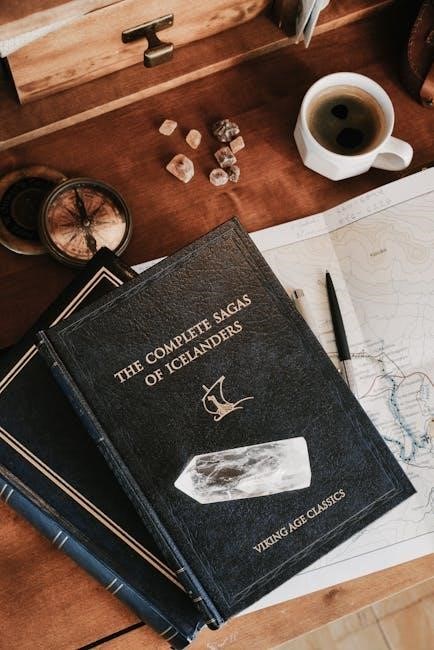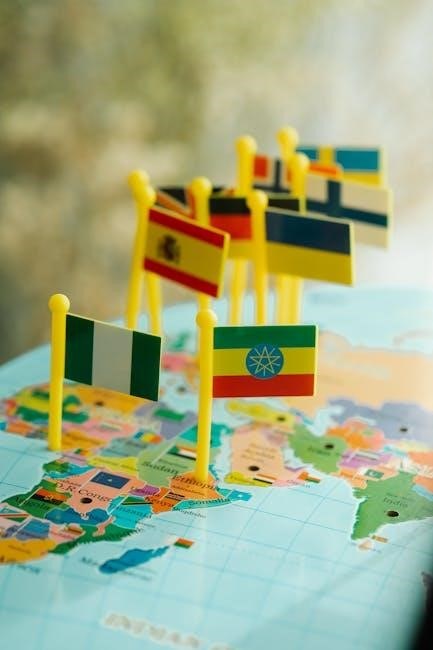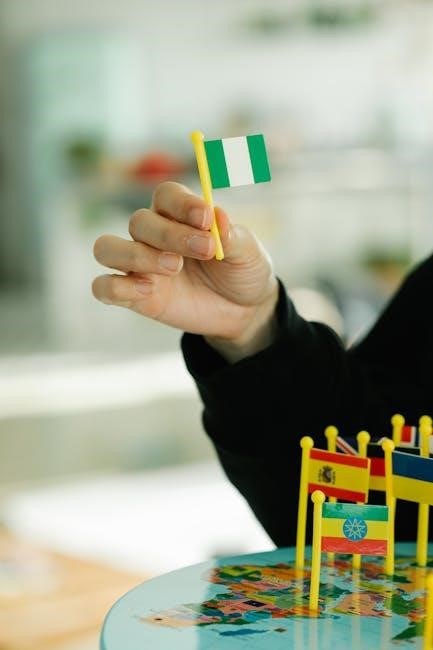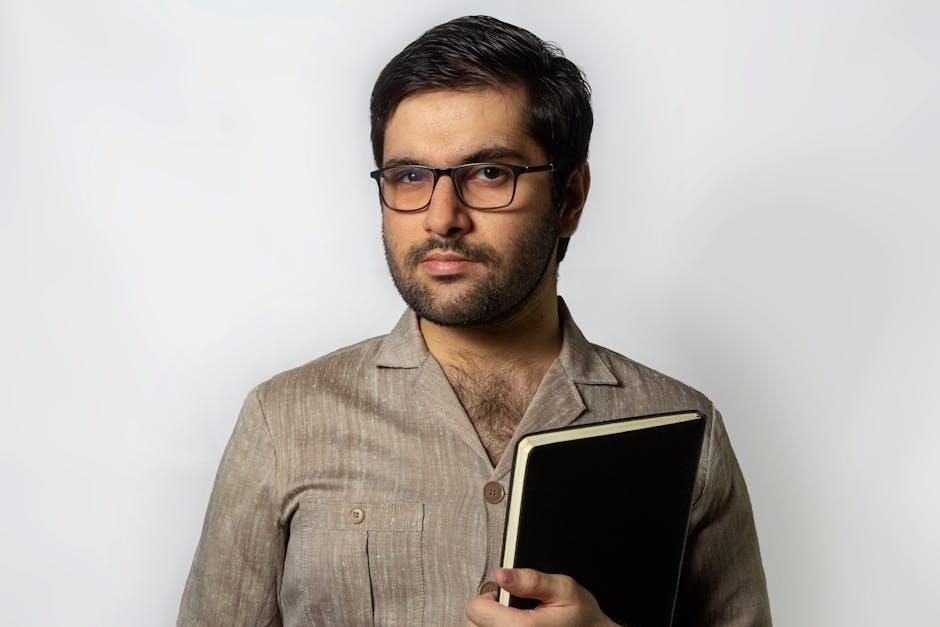Lord of the Flies, a thought-provoking novel by William Golding, explores human nature through a group of boys stranded on an island, delving into themes of civilization, power, and morality.
Overview of the Novel
Lord of the Flies, written by William Golding, is a gripping allegorical novel that explores the descent into chaos of a group of young boys stranded on a remote island after a plane crash. With no adult supervision, the boys initially attempt to create a utopian society, electing Ralph as their leader. However, their innocence and civility gradually erode as fear, power struggles, and primal instincts take over. The novel delves into themes of human nature, morality, and the effects of isolation, ultimately revealing the darkness inherent in humanity. Through vivid characters and symbolic elements like the conch shell and the beast, Golding crafts a tale that challenges readers to reflect on society, leadership, and the fragility of civilization.

Background Information on William Golding
William Golding, a British novelist, playwright, and poet, was born on September 19, 1911, in St. Columb Minor, Cornwall. His early interest in literature and science led him to study natural sciences at Oxford University. Before becoming a full-time writer, Golding worked as a teacher and served in the Royal Navy during World War II. His experiences during the war profoundly influenced his writing, particularly his view of human nature. Golding’s most famous work, Lord of the Flies, published in 1954, earned him the Nobel Prize in Literature in 1983. His writing often explores themes of morality, power, and the inherent darkness within humanity, leaving a lasting impact on modern literature.

Themes
Lord of the Flies explores themes of civilization vs. savagery, the nature of power, fear, and morality, revealing how human instincts lead to conflict and societal breakdown.
Civilization vs. Savagery
The conflict between civilization and savagery is central to Lord of the Flies. Initially, the boys attempt to create a structured society with rules, symbolized by the conch shell, representing order. However, as the novel progresses, their primal instincts dominate, leading to chaos. The shift from civilized behavior to savagery is evident through their actions, such as hunting and tribal rituals. This duality highlights Golding’s exploration of human nature, suggesting that without societal constraints, individuals revert to their baser instincts, leading to moral decay and violence. This theme underscores the inherent tension between humanity’s capacity for good and its tendency toward savagery.
The Nature of Power
The nature of power in Lord of the Flies is a dominant theme, as characters like Ralph and Jack struggle for control. Initially, Ralph’s leadership represents democracy and order, while Jack’s desire for power reflects a shift toward authoritarianism. The conch shell, a symbol of democratic speech, gradually loses its authority, mirroring the decline of civilized governance. Golding illustrates how power dynamics can corrupt even well-intentioned individuals, as Jack’s hunger for dominance leads to tyranny. The novel shows that power, when unchecked, can dismantle social structures and reveal primal instincts, highlighting the dangers of unchecked ambition and the fragility of leadership. This exploration underscores the inherent human struggle for control and authority.
The Role of Fear
Fear plays a central role in Lord of the Flies, driving the boys’ actions and shaping their behavior. The fear of the “beast” becomes a recurring motif, symbolizing the primal anxieties that lurk within them. Initially, the boys’ fear of the unknown unites them, but it eventually escalates into paranoia and violence. Ralph attempts to rationalize the fear, while Jack exploits it to gain control, revealing how fear can be manipulated for power. The fear of the beast also represents the boys’ growing awareness of their own savagery, as they descend into chaos. Golding uses fear to illustrate how uncertainty and dread can dismantle order and unleash humanity’s darker instincts, highlighting the destructive potential of unchecked terror.
Morality and Ethics
In Lord of the Flies, morality and ethics are central themes, as the boys’ actions reveal their inner moral compass. Initially, the conch shell symbolizes civility and fairness, fostering a sense of moral order. Ralph and Piggy represent reason and ethical behavior, advocating for cooperation and justice. However, as the novel progresses, the boys’ moral framework crumbles, and their actions become increasingly self-serving. Jack’s pursuit of power and hunting reflects a decline in ethical standards, while Ralph’s internal guilt over Simon’s death highlights the lingering presence of conscience. The novel questions whether humanity is inherently moral or if ethics are learned behaviors, ultimately suggesting that without societal constraints, moral decay is inevitable.

Symbols
Lord of the Flies is rich in symbolic elements, representing themes like civilization, fear, and power. Golding uses symbols to explore the inherent nature of humanity and society.

The Conch Shell
The conch shell is a pivotal symbol in Lord of the Flies, representing law, order, and political legitimacy. Introduced in Chapter 1, it is used by the boys to maintain democracy, as holding the shell grants the right to speak during meetings. This symbolizes civilization and the boys’ attempt to create a structured society. The conch shell also embodies fairness and equality, ensuring that every voice is heard. However, as the novel progresses and the boys’ behavior becomes more savage, the conch’s significance fades, reflecting the decline of civility and the rise of chaos. The shell’s destruction later in the novel marks the end of their democratic system and the complete descent into savagery. Through the conch, Golding explores the tension between order and anarchy, highlighting humanity’s inherent struggle to maintain civilization.
The Beast
The Beast is a central symbol in Lord of the Flies, representing the boys’ deep-seated fear of the unknown and their primal instincts. Initially, the Beast is perceived as a physical monster, but it evolves into a metaphor for the inherent evil within human nature. The boys’ fear of the Beast leads to paranoia and division, contributing to the collapse of their civilized society. Simon discovers that the Beast is actually the corpse of a pilot, symbolizing the externalization of their internal fears. The Beast serves as a catalyst for the group’s descent into savagery, highlighting Golding’s theme that true evil resides within humanity rather than in external forces. This concept underscores the novel’s exploration of human nature and morality.
The Lord of the Flies
The Lord of the Flies, a pig’s head impaled on a stake and surrounded by flies, is a powerful symbol in William Golding’s novel. It represents the true nature of evil, which is not an external force but an inherent part of human beings. The pig’s head, rotting and infested with flies, symbolizes corruption and the decay of moral values. When Simon discovers the Lord of the Flies, he realizes the true nature of the “beast,” which is the boys’ own primal instincts. This revelation underscores the theme that true evil lies within humanity, not in external monsters. The Lord of the Flies serves as a grim reminder of the boys’ descent into savagery and the loss of their innocence. It is a central element in Golding’s exploration of human nature and morality.

Chapter Summaries

Lord of the Flies chapters vividly depict the boys’ journey from unity to chaos. Ralph’s leadership, the conch shell’s significance, and the beast’s fear dominate early chapters. Simon’s tragic discovery and death mark a turning point, while the destruction of the conch shell symbolizes the end of civilization and the descent into savagery, highlighting the novel’s exploration of human nature and morality through key events and symbolic moments.
Chapter 1: The Arrival
Chapter 1 of Lord of the Flies introduces the story’s setting and main characters. A plane carrying British schoolboys crashes on a deserted island during a war. The survivors, including Ralph, Jack, and Piggy, find themselves stranded with no adult supervision. Ralph, tall and charismatic, explores the island with his friends. They discover a conch shell, which becomes a symbol of order and leadership. The boys gather around the shell, and Ralph is elected leader, representing hope for civilization. Piggy, the intelligent and rational one, advises Ralph. The chapter establishes the island’s beauty and the boys’ initial optimism, contrasting with the impending chaos and savagery that will unfold. The conch shell’s introduction highlights its significance in maintaining order and democracy among the group.
Chapter 2: The Formation of Society
In Chapter 2, the boys gather to discuss their situation and establish rules. Ralph, elected leader, emphasizes the need for organization and cooperation. The conch shell becomes a symbol of authority, allowing the holder to speak without interruption. The boys vote on whether to build shelters or hunt, highlighting their differing priorities. Jack’s desire for power and control begins to emerge as he focuses on hunting. Ralph and Piggy work together to build shelters, showcasing their commitment to civilization. The chapter illustrates the initial attempts at creating a structured society, with the conch shell representing democracy and order. However, tensions arise, foreshadowing future conflicts and the gradual unraveling of their civilized behavior. The boys’ optimism and unity are evident but fragile.
Chapter 3: The First Signs of Conflict
In Chapter 3, tensions rise as the boys face challenges like building shelters and hunting. Ralph and Jack disagree over priorities, with Ralph focusing on shelter and Jack on hunting. This clash marks the beginning of their rivalry. The group’s unity starts to weaken as some boys, frustrated with Ralph’s leadership, align with Jack. The conch shell’s authority is tested when Jack disregards Ralph’s decisions. Meanwhile, Simon discovers a hidden clearing, hinting at deeper truths about the island. The chapter introduces the first significant conflicts, showcasing how power struggles and differing priorities undermine the boys’ fragile society. These early disputes set the stage for the gradual descent into chaos and savagery. The boys’ initial cooperation begins to unravel, revealing inherent human tendencies toward conflict.

Character Analysis
Ralph, Jack, Piggy, and Simon represent different aspects of human nature, with Ralph symbolizing order, Jack embodying savagery, Piggy representing reason, and Simon seeking truth.
Ralph: The Leader
Ralph, the protagonist, represents order, leadership, and civilization. Elected as the leader, he strives to maintain discipline and focus on rescue through the signal fire. His priorities often clash with Jack’s desire for power and hunting. Ralph’s leadership is initially effective but erodes as fear and savagery grow. He embodies democratic values and rational thinking, yet his inability to control the group highlights the fragility of civilization. Ralph’s character evolves from innocence to a deeper understanding of human nature, ultimately realizing the darkness within. His journey symbolizes the struggle between civility and primal instincts, making him a central figure in the novel’s exploration of humanity.
Jack: The Antagonist
Jack Merridew, the antagonist, undergoes a significant transformation from a civilized choir leader to a power-hungry savage. Initially, Jack is eager to hunt and prove himself, but his obsession with power and control escalates. His desire to lead and dominate clashes with Ralph’s authority, fueling their rivalry. Jack’s fixation on hunting symbolizes his primal instincts and disregard for the group’s welfare. As the novel progresses, Jack becomes increasingly ruthless, forming his own tribe and embracing savagery. His actions, such as abandoning the signal fire and engaging in violent rituals, highlight his descent into chaos. Jack’s character represents the darker aspects of human nature, emphasizing the theme of civilization vs. savagery. His transformation underscores the novel’s exploration of humanity’s primal tendencies.
Piggy: The Intellectual
Piggy, the intelligent and rational member of the group, serves as the voice of reason. His glasses symbolize clarity and insight, while his weight and asthma make him vulnerable. Piggy’s logical thinking and adherence to rules often clash with the emotional decisions of others. Despite his physical limitations, he provides crucial ideas, such as using the conch shell for order. Piggy’s death, caused by Jack’s tribe, signifies the destruction of wisdom and democracy. His character highlights the importance of intellect in maintaining civilization, contrasting with the descent into savagery. Piggy’s role emphasizes the fragility of rationality and the consequences of its absence. His influence fades as the group prioritizes power over logic.
Simon: The Truth-Seeker
Simon, a quiet and introspective character, embodies innocence and wisdom. Unlike the others, he seeks truth through solitude. Simon discovers the “Lord of the Flies,” a pig’s head, which symbolizes the true nature of evil. He realizes the “beast” is a product of the boys’ fears, not an external entity. Simon’s tragic death, mistaken as the beast, underscores the loss of innocence and reason. His character represents moral clarity and the search for understanding, making his absence deeply felt. Through Simon, Golding highlights the importance of truth and its vulnerability in a chaotic world. His legacy remains as a symbol of lost innocence.

Study Questions
Study Questions engage readers in critical thinking through comprehension, analysis, and essay prompts, exploring themes, character development, and symbolic meanings in Lord of the Flies.
Comprehension Questions
What happens in Chapter 1 of Lord of the Flies? Describe the setting and the initial actions of the boys. How is the conch shell introduced, and what does it symbolize? Who are the main characters introduced in the early chapters? What is the purpose of the “beast” in the story? How does the group decide to organize themselves? What event in Chapter 1 highlights the tension between Ralph and Jack? What does Simon discover in the woods? How does the boys’ behavior change as the novel progresses? What role does fear play in their actions? How does the novel portray the transition from civilization to savagery? What is the significance of the Lord of the Flies itself?
Analysis Questions
How does the conch shell symbolize democracy and order in the novel? What role does fear play in the boys’ descent into savagery? How does Ralph’s leadership style differ from Jack’s, and what does this reveal about human nature? Why is Piggy’s character crucial in exploring themes of intelligence and morality? What does Simon’s discovery in the woods signify about the true nature of the “beast”? How does the novel portray the effects of isolation on societal structures? What message does Golding convey through the boys’ gradual abandonment of civility? How does the character of Simon represent innocence and truth? What significance does the title Lord of the Flies hold in relation to the novel’s themes? How does the ending reflect the novel’s commentary on humanity?
Essay Questions
Discuss how Golding uses the island as a microcosm of society in Lord of the Flies. Analyze the symbolism of the conch shell and its significance in maintaining order. How does the novel portray the effects of fear on human behavior? What role does leadership play in the boys’ survival, and how do Ralph and Jack embody different leadership styles? Explain how the theme of civilization versus savagery is developed throughout the novel. What does Simon’s character represent, and why is his death a pivotal moment? How does the novel critique human nature, and what message do you think Golding conveys? Use evidence from the text to support your arguments.

Resources
For further study, explore SparkNotes, BookRags, and Shmoop for comprehensive guides, summaries, and analysis of Lord of the Flies. These platforms offer detailed insights and study aids.
Online Study Guides
Online study guides for Lord of the Flies provide extensive resources, including chapter summaries, character analysis, and thematic insights. Platforms like SparkNotes, BookRags, and Shmoop offer detailed breakdowns of each chapter, helping students grasp key plot points and symbolism. These guides often include quizzes and essay topics to test understanding. SparkNotes is particularly renowned for its clear, concise summaries and analysis, while Shmoop stands out for its engaging, accessible writing style. Additionally, BookRags provides comprehensive study aids, including critical essays and teaching resources. These online tools are invaluable for students seeking to deepen their comprehension of Golding’s novel and its complex themes. They empower learners to explore the story’s depth independently or supplement classroom instruction effectively.
Websites like SparkNotes, BookRags, and Shmoop offer detailed summaries and analyses of Lord of the Flies, making them essential resources for students. These platforms provide chapter-by-chapter breakdowns, thematic explanations, and character studies, helping users understand the novel’s complexity. SparkNotes is known for its clear, structured approach, while Shmoop adds a engaging, humorous tone to its analyses. BookRags offers comprehensive study guides, including essays and teaching materials. These websites are invaluable for students seeking to enhance their understanding of Golding’s themes, such as civilization vs. savagery, and the symbolic elements like the conch shell. They serve as powerful tools for independent study or classroom preparation.



0 Comments